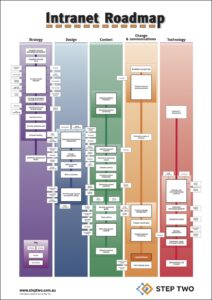
ABCD toy blocks from Shutterstock
Filed under: Articles, Intranets
Like organisations, intranets are constantly evolving and never finished. Endless redesigns as the intranet changes departments or owners is not a long term or viable solution. At any given time intranet teams are faced with competing operational priorities from:
- different business units
- out of date or excessive content
- new technology solutions
- sponsor and/or business initiatives
- over the top, loud people
Teams can also be distracted by the need to fight for recognition of the value of their intranets within their organisations.
Every intranet has a limited number of resources, often only one or two people, and limited funding. Despite this, successful intranet teams must deliver effective intranets that support their organisations.
‘ABCD for intranets’ is a step-by-step tool that can be applied at any time and then used for the continual refinement and improvement of the intranet.
Each step in has a number of key components and utilises existing tools and methods to deliver a specific outcome. This process provides a framework for constant evolution of your intranet in parallel with your organisation.
There are four key steps:
- Assess
- Brainstorm
- Consolidate
- Deliver
Four clear steps to improve your intranet
This article discusses the steps in detail. A summary table of ABCD for intranets is on page 3.
Who should use the ABCD?
The tool is designed for the person or team responsible for the intranet, whether they are located in communications, IT, marketing, strategy or anywhere else.
ABCD for intranets works best when:
- the intranet is inherited from another group
- a business case for resourcing and improving your intranet needs to be built
- the team wants to break the cycle of continually doing business-as-usual work and never actually making improvements
ABCD can also be used to improve specific sections of an intranet.
Who to involve
To ensure success in applying this tool to an intranet one person needs to own and lead the process overall. This person must influence the involvement of the correct people at each step.
Careful selection of people, based on their existing skill sets and motivation for the tasks, is crucial. One of the keys to success is exploring the personal needs of potential participants and aligning their needs with tasks.
During the early steps this is also a great opportunity to involve champions from within your organisation. They may not always have specific intranet skills, however they can bring immense value through their business knowledge and passion.
One of the keys to success is exploring personal needs
Commit the right amount of time
There are always competing demands on our time and resources. In addition to the usual challenges of competing projects, deadlines and business-as-usual work, intranet teams may also be challenged by:
- managers who think intranets are a waste of time
- being a lonely intranet team of one
- fire-fighting being normal practice in their organisations
- lack of strategic direction
- limited control over the intranet
Like the old adage, a stitch in time saves nine. Up front planning maximises the resources you have and reduces wasted efforts.
You may need to be creative about how to prioritise your time to complete the early steps.
Ideally getting the right people out of the office and together for the early steps would be beneficial. However you may also need to employ guerrilla tactics to get started.
For example, the intranet manager at Tabcorp, an entertainment company, found some time away from his desk to focus on a particular part of their intranet by marking themselves as out of the office for an additional two days after his holidays ended.
| Key concepts | How/tools | End of this stage | |
|---|---|---|---|
| Assess |
Where are you at today?
|
|
A clear picture of today |
| Brainstorm |
What could you do?
|
|
Wish list |
| Consolidate |
What should you do?
|
|
Concrete & committed plans |
| Deliver |
What you will do!
|
|
Evolving intranet |
Step A: Assess

It is impossible to make any practical and useful decisions without gathering a clear picture of where the intranet is today. Often intranet teams are so deeply entrenched in their day-to-day roles they cannot see anything positive about their own intranet.
Key concepts: where are you at today?
At this step you need to go on a fact finding mission and determine:
- what your staff actually need
- current key organisational challenges
- status of your current intranet
- style of organisation
- what it takes to run the intranet, including resources, workload and day-to-day issues
These steps do not need to be completed in any particular order.
Gather a clear picture of where you are today
How to and tips
This assessment can be done by one person or a group of people. Experience has shown that this task needs to be completed within a short time frame otherwise the review can get bogged down in analysis paralysis. Take too long and your work may be wasted as changes in your organisation and goals overtake all the effort the team has put into analysis.
A major key to success at this step is having an open mind and absorbing everything without judgement. This can be difficult when the intranet is your ‘baby’ but not impossible.
Before commencing the assessment you will need to determine the format you will present the assessment results in. For a large organisation this may be a PowerPoint presentation that can be used in briefings. In other organisations a one-page summary or a report may be more appropriate.
At the end of this step you will have a clear picture of where you are today.
Step B: Brainstorm

Bring along all the results from Step A. This step is all about creating a wish list of potential improvements for the intranet. Be sure to gather additional ideas, suggestions and whinges from all areas of the organisation.
Ideas need to be specific and measurable
At all times manage the expectations of staff. Provide feedback and explain all ideas will be collected and then pooled together for review against business criteria.
Key concepts: What could you do?
At this step you need to explore all possible options:
- gather ‘blue sky’ feedback from others
- identify business units with likely challenges
- research other intranets
- create a wish list
How to and tips
The key for this stage is that ideas do not need to be assessed or reviewed, however they need to be outcome driven.
One suggestion might be ‘to improve staff directory’. Work on generating less vague solutions, such as ‘expand staff directory to include east coast refineries and source standard information from payroll system’.
This example is specific and measurable, with results that can be easily determined.
Wish lists can be gathered in a variety of ways:
- Take along the mammoth to-do list for the intranet
- Use personal networks (or make use of someone who has a network)
- Seek out individual stakeholders such as management, IT, communications and marketing
- Review all suggestions made through intranet feedback forms
- Assess any relevant help desk calls
- Review results of research into staff needs
- Conduct some brainstorming sessions, making sure to target the experts and loud mouths
Short sessions are the most effective for brainstorming. Keep the energy levels in the room up. Consider using an independent facilitator for the sessions if the skills cannot be found in the team.
A useful guide on brainstorming techniques:
www.effectivemeetings.com/teams/participation/brainstorming.asp
CSL, a large pharmaceutical firm, used its long and very slow canteen lines as an ideal way to gather feedback while staff were waiting in line. Do you have a similar opportunity in your organisation? As you go, build up a visual display of the ideas near your workspace. This is an excellent way to build on ideas, create momentum for change and make the ideas come alive. It also makes a great talking point for any staff visiting the intranet team.
Rationalise the activities to focus on in the next 6 months
Before moving to the next stage remove duplications and collate the suggestions, possibly in a spreadsheet. If there are a large number of suggestions, group the suggestions by business need or areas of the intranet. This can be a fun exercise to do with the intranet team and can encourage buy-in to the process.
This wish list is now ready for the next step.
Step C: Consolidate

This is the riskiest stage. You are going to take your wish list and turn it into a plan. Hard and practical decisions have to be made.
Key concepts: what should you do?
At this step you need to decide and plan which activities you will do. Here’s how to go about it.
- Create a vision
- Set clear objectives
- Rationalise activities to focus on
- Create a plan including activities/resources/budgets
- Determine where time should be spent
How to and tips
A very effective way to improve the outcomes at this stage is to enlist the skills of a good project manager, someone who knows the organisation and has a track record of setting achievable time frames.
The key concepts are each supported by proven tools:
- Create a vision
(www.steptwo.com.au/papers/kmc_intranetconcept/index.html) - Set clear SMART objectives (Specific, Measurable, Achievable, Realistic, Timely)
- Rationalise activities to focus on (6×2 methodology)
- Determine where the intranet team will spend their time
At this stage the vision and objectives can be set by one person or a core group of people. Keep a keen eye on linking to organisational strategy.
For this task carefully consider who you should involve. Remember that some people from the brainstorming stage will have vested interests in their own suggestions.
Then when rationalising the activities use the tried and tested 6×2 methodology.
www.steptwo.com.au/papers/kmc_6x2
The 6×2 methodology focuses on utilising:
- criteria – your reasons for improving the intranet
- constraints – what can restrict your ability to deliver
Each possible activity is then run through the criteria and constraints. This process will cut your long brainstorm list down and identify activities that are both doable and worth doing. This prioritised wish list can then be turned into a project plan or work schedule.
Now comes an even harder step, where a good project manager will be most useful – planning the activities, resources and budgets. The method you choose may depend on your organisation, but in any case you will need to clearly specify deliverables, dates and resources.
Good project management skills are one of the keys to success
Generally a plan for six months is effective. Twelve months can be too long and the organisation inevitably will change in that time period. Three months can be too short to achieve significant improvements. The important point here is to take an iterative approach to evolving your intranet.
Remember that the team still needs to ‘run’ the intranet, while improving its effectiveness. At the planning stage, the team’s availability for the project needs to be factored in.
A good rule of thumb for the total intranet resources is:
- 30% effort on day-to-day maintenance
- 40% for projects and new initiatives
- 20% managing relationships with staff and stakeholders
This is true even for a team of one. At the end of this stage you will have concrete and committed plans for delivery. Do not fall into the trap of trying to do everything. Target achievable solutions that will make your intranet more useful and usable.
Resist the urge to roll several activities, constraints or objectives together to get more on the first list. This will limit the effectiveness of your planning.
Step D: Deliver

This step is where you build trust, credibility and momentum for the intranet by actually implementing something that provides tangible and visible benefits to staff.
Rationalise the activities to focus on in the next six months
Adopting a user-centred design approach is the best way to ensure the improvements are both usable and used by staff. Staff do not have the time or inclination to figure out how you think, they just want to do their job.
Key concepts: What you will do!
In our experience these are the key factors for intranet teams delivering something worldwide:
- deliver what you commit to
- track your progress regularly
- address team members’ individual needs
- measure success and celebrate
- identify failure and examine lessons learned
- ensure changes are implemented effectively
- deal with roadblocks
How to and tips
Managing the delivery stage is a black art that is more than making sure work gets done correctly and on time. The delivery stage involves leading everyone involved on the path to a more effective intranet.
Drawing on his experience leading software teams at Microsoft, Scott Berkun has written an excellent resource Making Things Happen: Mastering Project Management (ISBN 0596517718).
Deliver what you commit to
Some of our other tips include:
- Track your progressRegularly use the power of Wednesday meetings. These are designed to keep the project momentum by allowing enough time each week for tasks to have been completed, and they also take place early enough in the week to give others time to catch up on their tasks.
- Assess team members’ individual needsMost people will work their best when tasks align to their own needs. Do they want to learn that new bit of technology, visit state offices, or ensure they stay doing the same type of work? Understanding your team members’ needs is crucial at the delivery stage.
- Measure success and celebrateThere is nothing more disheartening than finishing something and getting more work to do. A small amount of encouragement goes a long way.
- Identify failure and examine lessons learned for improvementThere will always be something that does not go to plan. The key is to identify these situations early, accept them and then move on with replanning. Ensure changes are implemented effectively
Success is dependent on understanding the environment. Changes to the intranet will not in themselves result in changes to working practices. Success depends on operating within the organisation’s culture and working practices.
- Deal with roadblocksRoadblocks are inevitable, from projects that get a higher priority to stroppy managers and difficult people. Many intranet managers are just worn out by this. So take a moment to dispassionately assess the roadblock, and try reviewing the situation with another person who is not related to the project. By communicating the problem, the emotion can be taken out and it often becomes clearer what the true issue is. Then action can be decided upon.
- Deliver what you commit toThis cannot be repeated often enough. Don’t promise the world and deliver excuses. Commit to realistic targets and achieve them. Each time you deliver, your credibility and that of the intranet is improved substantially. Whatever you do don’t over-promise and under-deliver.
Test that your messages are being heard
Clear and effective communication
The importance of clear and effective communication is often stated, yet teams rarely move beyond blanket emails or updates on the home page.
At each step of the process you will need to communicate with:
- key stakeholders
- authoring community
- staff
- management
Carefully consider the right approach for each type of person at each stage of the project.
Ideas
Think beyond your usual methods and consider some options that are timely and in bite-sized chunks:
- SMS messages
- phone messages
- weekly elevator pitch
- presenting at other teams’ meetings
- ‘TQM bubble up methods’
- fridge magnet updates in tea rooms
Test that your messages are being heard by checking for understanding with some of your audience.
Summary
- Assess – where are you at today?
Create a clear picture of where you are now - Brainstorm – What could you do?
Collate a wish list for the intranet - Consolidate – What should you do?
Determine concrete and committed plans - Deliver – What you will do!
Deliver what you say you will and continue the journey of an ever-evolving intranet
All intranets are on a never-ending journey. To ensure this journey is productive for your organisation you need to determine an effective path to follow. ABCD for intranets is specifically designed to work at any stage in an intranet’s life.
It is essential that the outputs from each stage are completed, and that steps are not skipped.
To repeat the process, start again at Assess. This allows you to make a fresh, unbiased evaluation of the intranet and start to move forward again.
Communication with stakeholders, authors, staff and management throughout the whole process will be crucial to success.





